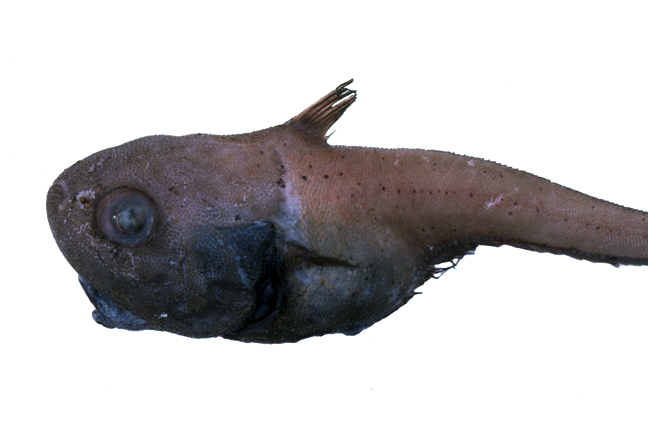Globehead Whiptail, Cetonurus globiceps (Vaillant 1884)

Globehead Whiptail, Cetonurus globiceps - trawled off Shoalhaven Bight, New South Wales, 1171-1207 m. Source: Ken J. Graham. License: © Ken J. Graham
The distinctive Globehead Whiptail, Cetonurus globiceps, has a massive gelatinous head, a very short trunk and a long, tapering tail.
Globehead Whiptail, Cetonurus globiceps (Vaillant 1884)
More Info
|
Distribution |
Off Crowdy Head, New South Wales, around southern Australia, to off North West Cape, Western Australia, including around Tasmania. Elsewhere the species is circumglobal in tropical and temperate waters. |
|
Features |
Dorsal fin II, 9-10; Pectoral fin 15-19; Pelvic fin 10-11; Gill rakers (first arch) 11-14; Branchiostegal rays 7; Pyloric caecae 7-11 Trunk very short, head massive, globose, soft and fully scaled; snout broad, rounded. Mouth small, moderately protrusible; anterior half of both jaws have small, conical recurved teeth, posterior portions of jaws toothless; chin barbel minute. Body scales small, covered with short, conical, erect spinules, those along and before anterior part of 2nd dorsal fin enlarged; lateral line reduced to series of dots (sensory neuromasts); large naked area surrounding anus and occupying most of the space between ventral and anal fins. First dorsal-fin base short, inclined, fin well-developed with elongate finely serrated spinous second ray; second dorsal fin rudimentary, rays much shorter than corresponding anal-fin rays; pectoral and pelvic fins relatively short, only outer ray of pelvic fin slightly produced. |
|
Size |
To 40 cm in length. |
|
Colour |
Body overall greyish to brownish black, fins dusky to blackish, mouth and gill cavities dark. |
|
Feeding |
Feeds on small fishes, planktonic crustaceans, cephalopod molluscs and echinoderms. |
|
Biology |
Unknown. |
|
Fisheries |
Although sometimes trawled in large numbers at depths between 900-1200 metres, the Globehead Whiptail is of of no importance to commercial fisheries. |
|
Conservation |
Not evaluated. |
|
Etymology |
The specific name globiceps is from the Latin globus (= globe, sphere) and -ceps (= headed) in reference to the globular shape of head of this species. |
|
Species Citation |
Macrurus globiceps Vaillant, in Filhol 1884, La Nature, Paris No. 559: 183, fig. 2 Type locality: Spanish Sahara, 23°57'N, 17°12'W. |
|
Author |
Bray, D.J. 2022 |
|
Resources |
Globehead Whiptail, Cetonurus globiceps (Vaillant 1884)
References
Iwamoto, T. 1999. Families Macrouridae, Bathylagidae, Moridae, Bregmacerotidae. pp. 1986-1998 in Carpenter, K.E. & Niem, V.H. (eds). The Living Marine Resources of the Western Central Pacific. FAO Species Identification Guide for Fisheries Purposes. Rome : FAO Vol. 3 pp. 1397-2068.
Iwamoto, T. 2015. Cetonurus globiceps. The IUCN Red List of Threatened Species 2015: e.T15522073A15603485. http://dx.doi.org/10.2305/IUCN.UK.2015-4.RLTS.T15522073A15603485.en. Downloaded on 22 February 2018.
Iwamoto, T. & Graham, K.J. 2001. Grenadiers (Families Bathygadidae and Macrouridae, Gadiformes, Pisces) of New South Wales, Australia. Proceedings of the California Academy of Sciences 52(21): 407-509 figs 1-114
Iwamoto, T. & McMillan, P.J. 2008. Family Macrouridae. pp. 320-347 in Gomon, M.F., Bray, D.J. & Kuiter, R.H. (eds). Fishes of Australia's Southern Coast. Sydney : Reed New Holland 928 pp.
Iwamoto, T. & Williams, A. 1999. Grenadiers (Pisces, Gadiformes) from the continental slope of western and northwestern Australia. Proceedings of the California Academy of Sciences 51(3): 105-243 figs 1-58
McMillan, P. 1994. Family Macrouridae. pp. 340-364 figs 304-325 in Gomon, M.F., Glover, C.J.M. & Kuiter, R.H. (eds). The Fishes of Australia's South Coast. Adelaide : State Printer 992 pp. 810 figs.
McMillan, P.J. & Iwamoto, T. 2015. 103 Family Macrouridae. pp. 747-827 in Roberts, C.D., Stewart, A.L. & Struthers, C.D. (eds). The Fishes of New Zealand. Wellington : Te Papa Press Vol. 3 pp. 577-1152.
Vaillant, L.L. 1888. Expéditions Scientifiques du Travailleur et du Talisman pendant les années 1880, 1881, 1882, 1883. Paris : G. Masson 406 pp. 28 pls.
Vaillant, L.L. in Filhol, H. 1884. Explorations sous-marines. Voyage du "Talisman". La Nature, Paris No. 559. 182-186 pp. (as Hymenocephalus globiceps)
Williams, A., Althaus, F., Pogonoski, J., Osterhage, D., et al. 2018. Composition, diversity and biogeographic affinities of the deep-sea (200–3000 m) fish assemblage in the Great Australian Bight, Australia. Deep-Sea Research II 157-168: 92-105.
Williams, A., Last, P.R., Gomon, M.F. & Paxton, J.R. 1996. Species composition and checklist of the demersal ichthyofauna of the continental slope off Western Australia (20–35º). Records of the Western Australian Museum 18: 135-155


